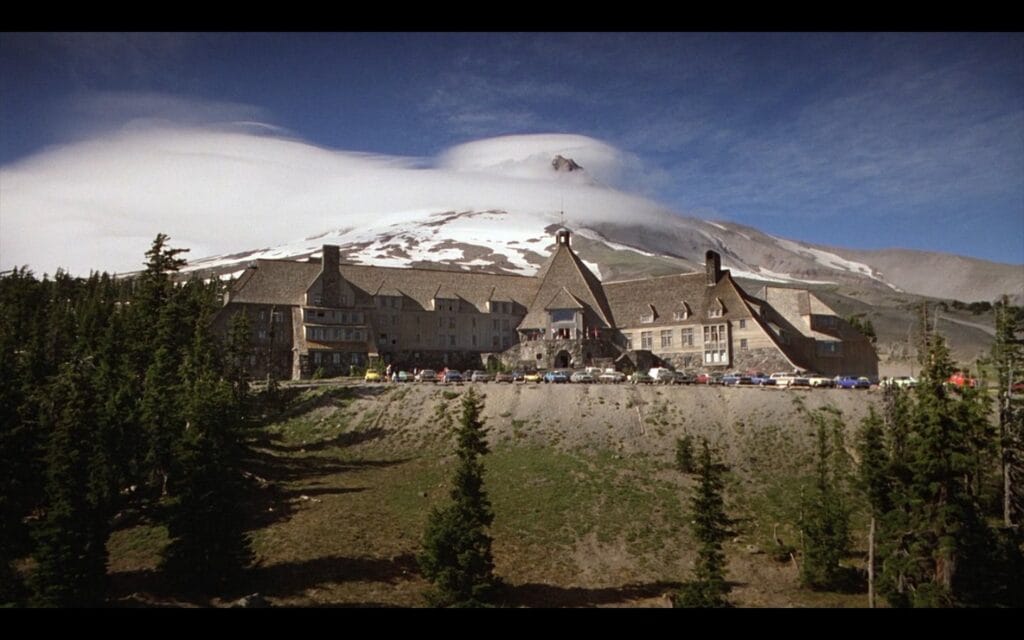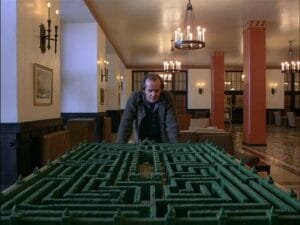A common theme in Gothic texts is that of the haunted house. In The Shining (Kubrick, 1980), The Overlook Hotel is no exception to this, as it contains many mysteries and horrors, which we learn through Danny’s psychic ability and the hotel manager as he introduces Jack to his new role as caretaker.
“The Shining’s Overlook Hotel functions as the traditional Gothic symbol of a haunted past; its climactic explosion and dissolution recalls Walpole’s Castle of Otranto, Poe’s House of Usher, and many other disintegrating Gothic structures.” (Clemens, 1999, p. 187). Although Clemens is discussing the Overlook Hotel in context of Stephen King’s 1977 book, and the hotel does not explode in the film, it is still relevant to the Gothic discussion in the sense of a haunted house.

This is reflected well in the film, especially in the scene where Wendy finds the bruises on Danny’s neck. Jack almost appears to be doubting his knowledge that he did not give Danny the bruises and goes to the bar to fantasize about having an alcoholic drink.
How do the formal properties of The Shining help establish it as a Gothic text?
The music has an important role in The Shining even from the very beginning with the helicopter tracking shot of the car driving through the mountains. Without the soundtrack, this scene is difficult to categorize, but with the inclusion of the ominous tones, it creates a sense of doom and that something is not right – almost that the car is being followed. “Music thus combines with image to evoke a sense of menace.” (Weinstock, 2019, p. 71, their emphasis). We later hear similar tones when Jack is looking over the model maze, signifying that he has “[…] become the unseen force looking down on the Torrance family and the Overlook hotel” (Weinstock, 2019, p. 73).

“As the camera follows Jack into Ullman’s office, viewers get an immediate sensation that they are eavesdropping on a rather private conversation. Perhaps the slight wavering of the Steadicam contributes to this impression.” (Falsetto, 2001, p. 160). This is another example of how the audience is captivated and instead of feeling like they are just watching the story, they would feel like they are a part of it, being trapped in the eerie atmosphere which accompanies many gothic horrors.
- [A corridor in The Overlook Hotel]. (n.d.). Retrieved 21 January 2025, from https://www.imdb.com/title/tt0081505/mediaviewer/rm3159062784
- Clemens, V. (1999). The Return of the Repressed. State University of New York Press.
- Falsetto, M. (2001). Stanley Kubrick. A Narrative and Stylistic Analysis. Praeger Publishers.
- Hill, R. (2005). The Shining. In A. Castle, The Stanley Kubrick Archives (pp. 446-459). Taschen.
- [Jack investigates the model maze]. (n.d.). Retrieved 21 January 2025, from https://www.imdb.com/title/tt0081505/mediaviewer/rm482102784
- King, S. (1977). The Shining. Doubleday.
- King, S. (1983). Danse Macabre. New York: Viking.
- Kubrick, S. (Director). (1980). The Shining [Film]. Warner Bros.
- Magistrale, T. (1988). Landscape of Fear. Bowling Green State University.
- [The Overlook Hotel]. (n.d.). Retrieved 21 January 2025, from https://www.imdb.com/title/tt0081505/mediaviewer/rm4147780864
- Weinstock, J. A. (2019). Michael Jackson’s ‘Thriller’ (1982) and Stanley Kubrick’s The Shining (1980). In S. Bacon, Horror: A Companion (pp. 67-74). Peter Lang Ltd.
APA7
Cable, J. (2025, Mar 11). How does The Shining (1980) exhibit Gothic conventions?. JCableMedia.com. https://www.jcablemedia.com/2025/03/11/how-does-the-shining-1980-exhibit-gothic-conventions/.
Chicago
Cable, John. “How does The Shining (1980) exhibit Gothic conventions?.” JCableMedia.com. March 11, 2025. https://www.jcablemedia.com/2025/03/11/how-does-the-shining-1980-exhibit-gothic-conventions/.
Harvard
Cable, J. (2025). How does The Shining (1980) exhibit Gothic conventions?. Available at: https://www.jcablemedia.com/2025/03/11/how-does-the-shining-1980-exhibit-gothic-conventions/ (Accessed: 03 April 2025).